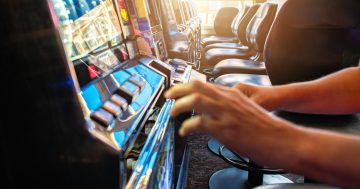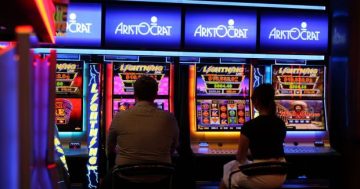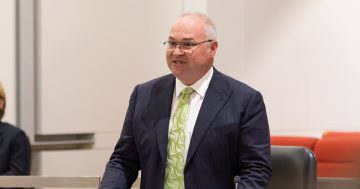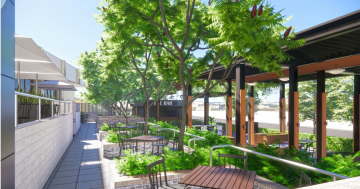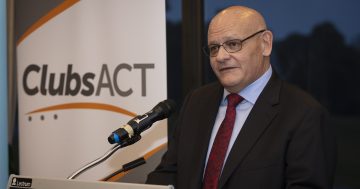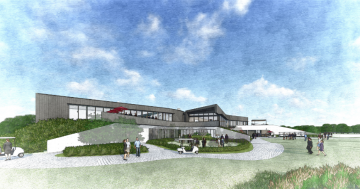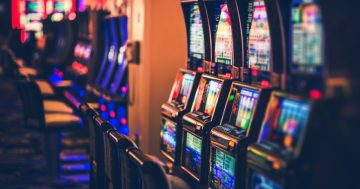
[First Filed August 24, 2009]
Poker machines are a strange game. In the long term, the only way to win is to not play. And yet, Canberra still gambled $56 every second last financial year, just on the pokies.
Canberrans love sport, and Canberrans their Clubs, and Clubs help make the ACT better by supporting the local sports that Canberrans love. I know this because ClubsACT tells me.
So if we all just chip in and churn part of our pay packet through the pokies every week, Clubs can do their part and support the Community through sport.
If the faces of people you see hanging around Clubs on their ads are to be believed, this is a bargain struck in heaven, and it is perfect in every way.
Personally, I’m so cynical that I find it hard to see the smiling happy people on the advertising as anything other than a marketing ploy put out by an industry body, and like most marketing messages, it doesn’t resemble the reality.
If you set foot in a Club for most of the time the machines are running, chances are about half of the people playing pokies will look like your grandmother, and they will be churning through $20 notes and making maximum bets like there was no tomorrow.
If the people actually playing the pokies when I walked into a Club were deliriously happy and all looked like attractive blondes, I probably wouldn’t care what they did, so long as I could join in.
Here in the ACT we have our Gaming Machines Act 2004 which requires Clubs to contribute 7% of Net Gaming Machine Revenue at a minimum, in order to help the Government justify to the taxpayers why we have poker machines within the ACT.
The claim is made that 7% of Net Gaming Machine Revenue (NGMR) is good for the community as a whole.
If Clubs contributing 7% of Net Revenue is a good thing, all of the Clubs voluntarily contributing a bit over 14% back into the community must be a great thing, surely?
On the other hand, when it comes to seeing beyond the happy marketing push:
(A Megaclub is classed throughout this article as an individual entity receiving more than $2,500,000/year from gaming activities, a Megaclub Group is one which receives more than 85% of total gaming income from Megaclub-class operations)(38%. Source: Australiasian Gaming Council, Australian Gaming Database 2008, Pg60, Figure 5-1 ACT Gambling Participation (2005-06), copies available here)($7640 per capita, only NSW is higher. Source: Australiasian Gaming Council, Australian Gaming Database 2008, Pg20, Table 3-1 Summary: Aggregate and per capita gambling expenditure in Australia by state/territory (2005-06), copies available here. I get about $6749 per capita for FY07-08 using GGMR/10% losses/ABS stated adult population for the period)(20.4 machines per thousand adults versus a national average of 12.6. Source: Australiasian Gaming Council, Australian Gaming Database 2008, Pg9, Figure 2-1 Gaming machines per 1,000 adults in Australia by state/territory, copies available here. Personally I get 19.66 machines per thousand using ABS stats for the period, but this is still higher than NSW at 19.0 per thousand)(Source: ACT Gaming and Racing Commission, Community Contributions made by Gaming Machine Licensees 1 July 2007 to 30 June 2008, Attachment C: Required and Actual Community Contributions – Licensed Clubs , Pg 20 &21)(Source: ACT ACT Gaming and Racing Commission, Community Contributions made by Gaming Machine Licensees 1 July 2007 to 30 June 2008, Attachment C: Required and Actual Community Contributions – Licensed Clubs , Pg 20 &21)(Source: ACT Gaming and Racing Commission, Community Contributions made by Gaming Machine Licensees 1 July 2007 to 30 June 2008, pg26, and Elections ACT, Australian Labor Party (ACT Branch) 07-08 Financial Disclosures)(Source: ACT Gaming and Racing Commission, Community Contributions made by Gaming Machine Licensees 1 July 2007 to 30 June 2008, Attachment C: Required and Actual Community Contributions – Licensed Clubs , Pg 20 &21.
Those Megaclubs contributing 14% NGMR or greater were: Belconnen Magpies Sports Club, Eastlake Football Club, Lanyon Vikings Sports Club, Vikings Town Centre Sports Club, Vikings Erindale Sports Club, Ainslie Football & Social Club, and Gungahlin Lakes & Golf Community Club)In return, ACT Labor lets the Club sector operate its machines under one of the most favourable gaming tax regimes in the country, and everybody involved claims it’s for the public good.
Tax rates are so low that politicians can say that Canberra’s poker machine problem is nothing to worry about, since it only makes up 3.5% of the Canberra tax revenues. Stanhope can even stand up at annual Clubs conferences and sing high praise of the sector his party receives the largest donations from.
Heck, it’s apparently so good that there is a discussion paper from ACT Treasury (early version here, without submissions) which, if the policy is adopted, may let Clubs redistribute some of their underperforming poker machines from one location and put them into more intensive (as in profitable) usage, or even buy the less competitive operators out of the market, so the Megaclubs can rake in even more revenue from more mortgage-offsetting workers and elderly suburban grandmothers who are now cashed-up widows since the estate cleared.
Since the ACT Treasury would get a 21% share of larger revenues from fewer operators, and a sane Treasury will never say no to more money, it could be a viable option to help support whatever uncosted but taxpayer-funded program the ACT Labor Party dreams up in future, or just pay for the next Fringe Festival.
If a policy helps derive greater tax income from a single sector, couldn’t that make the ACT more dependent on poker machines?
Are we meant to believe that if a policy helps the single sector which contributed the largest sums to the governing ACT Labor Party, then there’s no potential for conflicts of interest?
But since some of that funding is going on sport through Community Contributions, it must be good for the public, so we should just sit back and accept it, right?
Wiser people than me have said it before, but here goes:
When you have doubts about what you’re being told, follow the money and see for yourself.
Luckily, when it comes to following the money, every Club is required by law to file a notice of Community Contributions by July each year, and the Treasurer is required to report the Community Contributions to the Legislative Assembly by October, at which point the records get made public, so everyone can have a look.
These reports indicate both the minimum contribution required from each Club, and any discretionary contributions a Club may want to make on top of their mandatory seven percent.
Since FY2006-07 the ACT Gaming Commission has included in the reports the Gross Gaming Revenues for each Club; and with that key piece of information you can league table an industry.
You can see who are the major players and their market share; work out how much an average poker machine will take in a given Club, how much cash Canberrans will put into poker machines on an annual basis, and also, how intensively the machines are used.
If you only look at aggregate data for Community Contributions, or the nice bolded figures which total up an entire sector instead of specifics, everything seems peachy.
Clubs in the ACT contributed 14.57% of their net gaming revenues (NGMR) to community causes throughout the year, instead of the minimum seven percent. Great.
The Big Four Club groups in Canberra contributed 38.54% of the total contribution. Nice.
Those Big Four Club groups make up 51.72% of all poker machine income in the ACT. Not so nice.
The Labor Club Group as a whole, fountainhead of ACT Labor Party finance, contributed only 0.77% NGMR above minimum back to the community. Three of the Labor Clubs scrape in barely above minimum, contributing back in total only $4698.50 above that required by the law.
Ginninderra Labor Club contributed only $631.44 (0.03%) above minimum, or about an hour’s takings.
Also, the formula used to calculate these contributions is skewed in favour of letting the large operators contribute back relatively less than the smaller operators. (More on that one down below.)
These Contribution Reports are visible over at the ACT Gaming and Racing Commission website here, if you really want to go and have a look.
Clubs ACT tell you on their website that under ACT law Clubs can never be owned or operated by a Corporation and so none of the profits on gaming are able to return to private hands, somehow rendering their entire enterprise a noble one.
Conversely, if none of the return can be accrued into private hands, and Clubs are raking in millions of dollars every year, once wages and costs have been deducted, they have little choice but to continue gilding their lilies by redecorating and refurbish the buildings, or otherwise invest in their own operations.
They can either operate at a loss, break even, or return the profits to themselves and keep increasing in size, gradually becoming Pacman-like behemoth, consuming all smaller operators who fail to keep up, in the name of “building a community asset for their members”.
- Gaming Tax is Effectively Flat, Community Contributions are Regressive
Unfortunately, when you read the Gaming Machine Act 2004, Community Contributions are defined by a rather regressive formula.
In practice our Gaming Taxation might as well be a flat tax formula, in that almost everyone who pays gaming tax falls into the one margin.
54% of the ACT’s operators, and 99% of ACT Gaming Tax Revenue comes from the highest tax margin.
The remaining operators only contribute in 1% of the gaming tax revenue each year.

Once they fall into that magic 21% tax margin, there are no further margins to worry about falling into, which would diminish their own return through tax penalties like every other state in the country.
(Click on the image for an indication of the relative value of Clubs in terms of tax contributions.)
Also a result of including after-tax Gaming Revenue in the formula for Required Contributions, the larger the operator, the smaller the percentage contribution to the Community they are required to make.
This is what “7% of NGMR” means, in theory:
The first $180,000 annual income must return 5.32% of losses directly to the Community, since they pay no tax.
The next $120,000 will be returned at 4.27% directly to the Community, and 15% to the ACT Government as tax.
The next $300,000 will be returned at 4.13% directly to the Community, and 17% to the ACT Government as tax.
Each dollar above $600,000 annual income will be returned at 3.85% directly to the community, and 21% to the ACT Government.

As example:
Federal Golf Club, has only $41,018 in gaming income, but pays no tax on it.
It has a required contribution back to the community of $2,182.18, or 5.32%.
Canberra Labor Club, has $15,051,667 in gaming revenue, but pays an average tax rate of 20.62% on each dollar it earns due to margining.
It has a required contribution back to the community of $583,478.98, or 3.88% of GGMR.
So in effect, the Government can put up as many golden statues as the tax income will allow regardless of Club size, but the actual percentage returned directly to the Community gets smaller and smaller as the Clubs get larger. Thanks to some extra provisions in the law, you can actually only contribute three-quarters of the required amount, so long as it gets spent either on women’s sport or programs which control problem gambling.
Snapshot of the basic data:
By the population numbers available from the Bureau of Statistics, with 5087 poker machines operating through the entire financial year, the ACT had 19.66 machines per thousand adults in FY 2007/08, against a national average of 12.6 according to the Australasian Gaming Council.
While that number is gradually falling as population increases (since the number of machines in the ACT are capped at 5200), it just means we will be using the existing machines more intensively as time goes on, and so income per machine will increase also.
Canberran poker machine players put somewhere in the range of $1.36 billion and $1.77 billion[1] into poker machines during FY 07-08.
According to Bureau of Statistics population data for the period there were 262,742 adults in the ACT.
This means that on average, every adult in the ACT gambled between $5191 and $6749 [1] in FY 07/08 just on the pokies.
[1]: I can only be this accurate because I am working off Gaming Commission returns and Gross Gaming Machine Revenues of $177,311,623 in the reporting period.
ClubsACT claim the typical Club returns 90% of turnover to players
Bear in mind that Clubs can actually set the rate of return at whatever they like; the legislated minimum return to player (RTP) in the ACT is $0.87 for $1 turnover (ie: Club takings of 13 cents per dollar), or turnover of about $1,363,935,562. ClubsACT (the industry body) asserts that a typical RTP of its members is $0.90, so would represent $1,773,116,230 of turnover.
Also keep in mind that ClubsACT has stated that its mission is to “present a good public image of clubs”. They also claim that the ACT Government only makes a 15% after-tax concession for operating the machines, when the law states it is a 24% after tax concession, and the Gaming Commission acts according to the law, so 24% is conceded.
(I will be using the Clubs ACT 90% return figure, because it both portrays the industry as the size they claim, and it also just makes the sums easier )
Operators:
Canberra had 62 Clubs operating gaming machines for the entirety of the FY 07-08.
The Largest Individual Megalubs:
The Largest Megaclub groups:
From here on in, I will be referring to these Clubs as The Big Four, since these 15 Clubs (less than 25% of the registered licensed Clubs in the ACT) command more than half of the ACT gaming revenue.
Machines
For the number of machines, Canberra had 5087 poker machines operating for the entire financial year.
2284 (44.90%) machines in total were owned by the Big Four being:
2803 (55.10%) of these were owned by other Clubs.
Losses
In Gross Gaming Machine Revenue (GGMR) terms, in the FY07-08 Clubs in Canberra received $177,311,623 from gaming losses.
Total figures
Of this, $91,710,562 (51.72% revenue share) was received by the Big Four Megaclub Groups, being:
$85,601,061 (48.28% revenue share) was received by other Clubs.
Turnover per machine:
Player losses across the whole ACT averaged $34,856/machine (or turnover of about $6703 each week on every machine in the Territory).
For machines owned by the Big Four, across the 07-08 financial year the average earning was $40,153 per machine, or up to $7720 in turnover each week.
To achieve this, the average machine owned by the Big Four had an average turnover of up to $401,535 [1] for the financial year.
For machines owned by anyone else, the average was $30,540 per machine (turnover $5872.90/week).
The average poker machine owned by anyone else had up to $305,390 [1] churned through it.
The best performing Clubs in the ACT for 07/08 per-machine earnings and my estimates for turnover were:
If you are affected by problem gambling or would like more information about problem gambling, call Lifeline – their Gambling Care service can provide free financial counselling.
Ph: 02 6247 0655.
Link to Lifeline – Gambling Care’s website
(Disclosure: The author is a member of the Canberra Southern Cross Clubs (There is free parking at Woden), the Canberra Irish Club (They serve Guinness by the pint, it tastes better and is cheaper than in Civic), and the Tuggeranong Vikings Clubs (The steaks are good on Saturdays, but the service can be slow))












